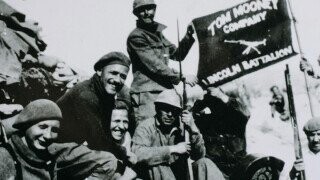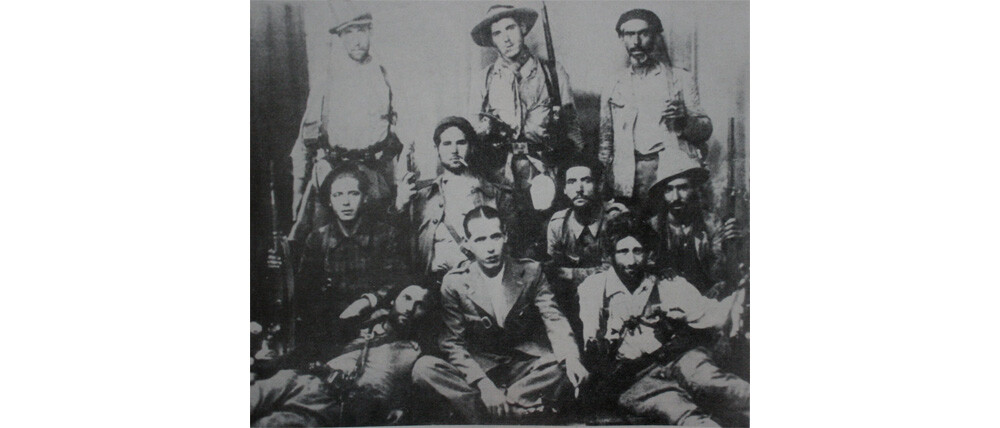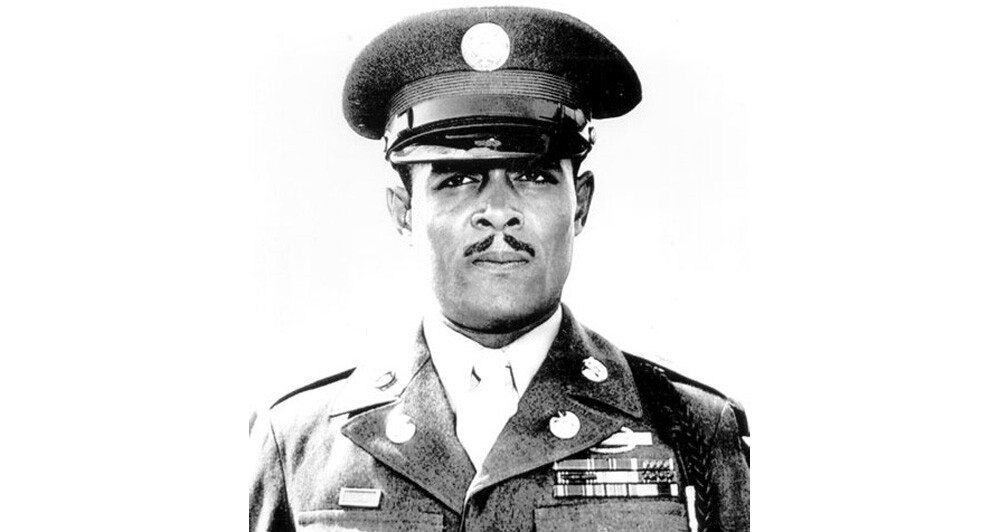This Machine Killed Fascists: The Story of Delmer Berg

Way back in 2016, when John McCain was famous for fathering The View's best hairstyles, he wrote an op-ed in the socialist party newsletter entitled Salute to a Communist.
Saluting communists isn't exactly on-brand for American politicians, especially one from a state that produced a certain chemical-themed presidential candidate. But this wasn't any Communist that McCain was saluting; it was a man named Delmer Berg. Like other oddly named American heroes, Delmer was into smashing fascism. And unlike Portlanders swimming in rivers of tear gas, Delmer was doing it before it was cool.
Delmer Volunteered To Fight Fascism Before World War II
Don't Miss
Delmer Berg wore many hats throughout his life, though they probably all had holes in them. He was a farmer, landscaper, stonemason, and union organizer in a time when anti-union forces would beat the piss out of workers to prevent them from organizing (as opposed to now, where they create a bunch of bots on Twitter denying that they have to piss in bottles). He was working as a (unionized) dishwasher when he saw a billboard put up by the Young Communist League, which is apparently still a thing in the United States, recruiting for the International Brigades to fight in Spain.

The International Brigades were a project of the Communist International (or Comintern, for those of us who are really in the know about their communism) meant to recruit people worldwide to fight in Spain, where a destructive and terrifying civil war was unfolding at the time like Satan's own cootie-catcher. The war was fought between Republicans (the democratically elected left-wing 'Popular Front' government) and Nationalists (a fascist military rebellion under Generalissimo Francisco Franco, who is still dead).
Because communists are better at advertising than they have any right to be, each brigade was pitched with an inspirational name to rally troops to the Republican cause. The French and Belgian unit, for example, was named for the Paris Commune; the (mostly) Italian unit was named for Italian unifier and nationalist Guiseppe Garibaldi (which was how they named another multinational unit of the American Civil War); the American units of the war were named for George Washington and Abe Lincoln. (Eventually, the George Washington Battalion would be absorbed into the Lincoln Brigade for reasons that'll be clear in a minute.)

via Wiki Commons
The largest contingent was French, but there were significant numbers of troops from all over, including Germany, Poland, England, Ireland, (what was) Czechoslovakia, Hungary, (what was also) Yugoslavia, and the nations of Scandinavia. People even came all the way from New Zealand to fight, giving a whole new meaning to that scene in The Lord of the Rings. In all, more than 35,000 troops from 52 countries traveled to Spain to fight for the Republican cause.
Now, when you read sources about the civil war, you come up with all sorts of different numbers in terms of the size of the International Brigades and the number of nations represented in them. Turns out things got real complicated, real fast, like they do in any war.
He Had To Fight Just To Get To The Front
Delmer started volunteering with the communists, collecting clothing for the war effort. With his experience as an Oregon National Guardsman, he was valuable enough as a soldier to be sent to the front.
Of course, he couldn't just hop on a boat and get there; first, he had to get to France, then sneak his way south through the Pyrenees Mountains (you know, where Andorra is). That's because few states were interested in helping the Spanish Republic, let alone allowing their people to pick up guns and go fight. The US declared its neutrality in the conflict in 1937. Other democratic nations of Europe were loath to support the Republicans, probably because they didn't want to spark another world war (which, of course, worked completely) and their discomfort with the politics of the Spanish government.

The Popular Front, elected to power in 1936, was a ragtag collection of the entire leftist action figure line: liberals, socialists, communists, even black-flag waving anarchists. The reforms put forth by the government promised a Spanish social revolution, which is a pretty quick line between almost feudal empire and socialist revolution.
Before 1936, Spain was trying desperately to hold onto its former glory. It had gone from being a world power in the 19th century to a piddling one. They spent the first years of the 20th century lurching between governments, fraying into disorder, and generally having a bad time. They'd suffered utter humiliation at the hands of the United States and had their empire smashed and taken.

The last vestige of the Spanish Empire was Morocco, which exploded into an anti-colonial war in the 1920s. Spain held onto Morocco for dear life, which they did through early 20th-century counterinsurgency, i.e., all the terrible ideas, up to and including chemical warfare. The war was bitter as hell, and that's why Spain's most experienced troops were stationed there. It's also why when Franco's Nationalist rebellion started, it got the support of the Spanish Army of Morocco.
There were a couple of small problems with this, though. First, jackboots are never as appealing a fashion choice as fascists seem to believe, and second, the Mediterranean Sea separated mainland Spain from Franco's rebels. What kept Franco in the game was that both Italy and Germany, which had both recently turned fascist, provided a hell of a lot of support to the fascist rebels, including tens of thousands of troops, arms, and ships.

When Franco asked Hitler for a few transport planes to help move his troops to the mainland, Hitler did him a solid and sent him a whole damn Condor Legion, importantly including experienced pilots to fly them (after Spanish pilots started crashing them). These weren't old junkers either; they were, in fact, new Junkers, Messerschmidts, and Heinkels -- the most technologically advanced aircraft of their day. The fascists organized the first airlift of soldiers in history, getting them to the mainland to fight the Republicans. Nationalist airpower played a huge role in the war, playing hell on the Republican forces and providing an awful prelude to WWII with the Bombing of Guernica.
That's why, when Del Berg was sent to the front, he was assigned to an anti-aircraft unit, trying to help defend the Republicans against the superior air power of the Nationalists.
"Trying," unfortunately, is doing a lot of heavy lifting in that sentence.
Fascist Shrapnel Couldn't Stop Him
What Del was joining when he crossed the Atlantic was originally a group of 96 guys that sailed for Spain the day after Christmas in 1936. The Lincoln Brigade wasn't the best-equipped or trained force there ever was. While Del did have some military training with the Oregon National Guard, the vast majority didn't have any, and they certainly didn't get much when they arrived. Some soldiers report being given "100 bullets and a rifle" and told to go fight. What's commonly referred to as the Lincoln Brigade was actually three separate units: the Lincoln, George Washington, and the Mackenzie–Papineau Battalions, the latter being the Stan Rodgers of the anti-fascist folk band. Unfortunately, the units were constantly reorganized and regrouped because of, you know, all the death.

via Wiki Commons
There were few battles where the brigade didn't get bloodied. Half of the brigadiers were casualties, and a full third of the American Brigaders fell in battle (by comparison, in World War II, .02% of people who served in the US Army actually died on the battlefield), likely because they were inexperienced, and they were being used as the shock troops of the Republican forces. They were killed at three times the rate of the rest of the Republican army, so much so one of the survivors told a reporter: "You can say that the battalion was named after Abraham Lincoln because he, too, was assassinated."
There's a thread in people's understanding of the Lincolns that they were erudite (maybe even foppish) romantics, going over to Spain to fight a war for democracy and look dashing in fancy uniforms. Likely, they get this idea from all the writers who supported the war, including Ernest Hemingway, George Orwell, and James Hetfield. But most of them were just regular schmoes like Delmer: dockworkers, union organizers, and laborers with a few fact-checkers and actors thrown in for good measure.

Their numbers included the more than 90 African-American soldiers who served alongside – and commanded – their white American brethren. They came to fight both the fascists who threatened to take Europe and the fascists who were destroying Ethiopia because they were the same thing.
The brigade saw action in multiple battles across the Spanish countryside but got the worst of it in the Battle of Jarama (note: anytime there's a battle with a Suicide Hill, it's real bad.). It was likely in support of that battle that Del got a piece of fascist shrapnel in his liver. An Italian bomber in Valencia took out the monastery where he was staying, even though they were aiming for a rail station nearby (precision bombing being a thing we just made up, even today.) He would carry that piece of steel in his liver for the rest of his life, because like Teddy Roosevelt knew, it's sometimes better to carry around a bullet in your guts rather than having some yahoo in a white coat rooting around in said guts.
The Last Volunteer ... Never Stopped Volunteering
You would think that old Delmer would've seen enough of fighting fascists that he would've sat out the biggest anti-fascist action this side of Portland, but he didn't. He volunteered to fight Japan's troops in the Pacific until he was sent home in 1942 because of, you know, the shrapnel that was still in his liver.
Del was actually rare among the Brigaders because the American government, though they were knee-deep in the fight against fascism, weren't super-pumped about a bunch of ragtag lefty-commie-pinko-socialists becoming GIs. The Veterans of the Abraham Lincoln Brigade were put on a list of subversive organizations and monitored more closely than the legal filings of Britney Spears. When they were allowed to serve, they were never allowed to rise above the lowest ranks of the military. One soldier, who went on to win the Medal of Honor for his service in the Second World War, was being tailed for his "suspected communist exposure" for his time fighting fascism in Spain.

Delmer, of course, was flagged for communist exposure when he ... joined the American Communist Party as soon as he returned home from the war. He worked with the United Farm Workers in California as a union organizer, and one of his proudest moments was being elected VP of the NAACP. He was their only white member because, while the arc of history is long, it's also pretty bumpy. He also protested against nuclear weapons, the Vietnam War, and probably thought Twitter should be burned to the ground, like all good Americans.
Of course, the Feds were hot on Del's tail through the course of his career as a leftist activist, especially one who joined the Communist Party. But what saved him was the fact that his house was between a whorehouse and a church on the wrong side of the tracks in Modesto, California. Cops weren't keen on going into that neighborhood because that's where the *gasp* Black community of Modesto lived. The House Un-American Activities Committee tried in the '60s to serve Del papers, but they couldn't seem to find him either. Of course, that didn't stop them from keeping a file on him, which you can find here.

Delmer Berg died in 2016, aged 100, as the last living member of the Abraham Lincoln Brigade. The last living member of the International Brigades died last year, right as the world seemed to fall apart.
So pour one out for the International Brigades, and remember Delmer Berg: the greatest communist ever eulogized by John McCain.
Steven Assarian is a librarian. He writes stuff here.
Top Image: Wiki Commons
